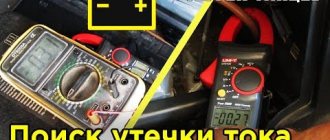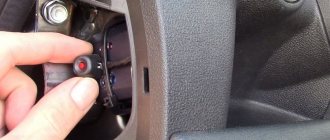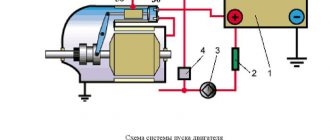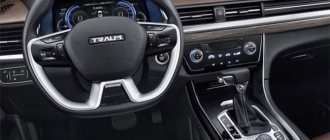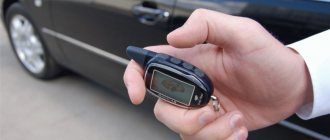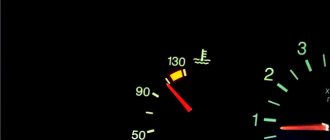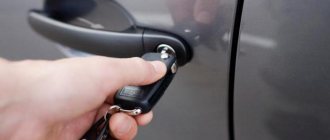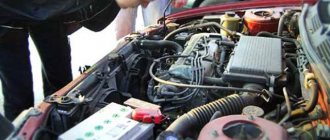Despite the fact that the VAZ 2114 runs on gasoline, the electrical component in it is very important. Without maintaining the voltage within the required limits, the lighting will not be able to work, and the battery will be discharged. And most importantly, the ignition system will not be able to function without electricity, which means the engine will not work. Therefore, it is important that the electrical circuit of the machine is maintained in good condition.
Checking the functionality of the voltage regulator is a very important event.
Why doesn't the starter turn?
Contacts
The simplest and most easily remedied reason is poor contact; there is no difference between the carburetor and the injector. There are quite large currents in the starter, generator, and battery circuits; the slightest deterioration in electrical contact leads to local heating, oxidation, a further increase in current resistance and a parasitic voltage drop.
The terminals of the VAZ 2110 battery must be removed, cleaned of dirt, the contact surface must be treated with fine sandpaper, carefully placed on the battery contacts without distortion and tightened with a wrench. The wires from the battery to the housing, generator, starter, as well as the connection to the ground of the generator and starter are checked. The contacts are cleaned, the nuts and bolts securing them are tightened.
You can learn more about the causes of starter malfunction in a VAZ 2110 car here: https://vazweb.ru/desyatka/elektrooborudovanie/ne-krutit-starter.html
Battery
The most obvious reason is battery failure.
If it is more than five years old or it has been completely discharged a couple of times (for example, they forgot to turn off the lights or lights in the cabin when leaving the car for a long time), then this is completely natural.
Such a battery will externally charge (quickly due to the sharply decreased capacity), but will not be able to provide the starting current necessary for starting. You can drive with it, but starting a cold car, especially when the temperature drops, is impossible.
If the bank fails or there is an internal short circuit, the output voltage decreases, which is easily determined with a multimeter. There is only one way out - replacing the battery.
Leakage current
The most hidden reason is a large leakage current. When all consumers in the car are turned off, the battery still gradually discharges; this is a self-discharge current due to the design and operating principle of the battery.
Additional leakage current is caused by incorrectly connected devices, damaged wiring and, oddly enough, dirt on the battery case. We clean the outside of the battery from dirt with a rag, especially the upper plane and near the terminals, disconnect the negative wire, insert a multimeter into the gap in current measurement mode to the maximum limit.
Lowering the measurement limit, we obtain the first values. For a VAZ 2110, a current of 3–5 milliamps (mA) will be an excellent indicator, up to 15 mA is normal (especially when the alarm is on), with a value of more than 30 mA (for an injector 50 mA), you need to look for a “malicious” waste of electricity.
The easiest way to do this is to remove the fuses one by one to detect the circuit in which the faulty consumer is hidden. If you don’t have a multimeter, you can turn on a 12-volt test lamp instead; if the leakage current is high, it will light up. The cigarette lighter, starter and generator on an injection engine are not protected by fuse links; they are checked by disconnecting the wires themselves.
The technical characteristics and operating principle of the generator in the VAZ 2110 car are studied in detail in this article: https://vazweb.ru/desyatka/gena/generator.html
Undercharge
Probably the most common reason for a VAZ 2110 is an undercharged battery. The energy spent on starting the engine must then be replenished.
The current generated by the generator, the value of which increases with increasing engine speed, powers the ignition system, other consumers (headlights, heater and radiator fans, air conditioning, interior and trunk lighting, music, heated seats, cigarette lighter, etc.), and the rest goes to charge battery.
If the generator or relay-regulator fails, there will not be enough current for charging; this malfunction will be indicated by a light on the dashboard.
How to find out the exact reason why your car battery drains quickly
It is necessary to move from assumptions to repair and adjustment work in tandem with a multimeter.
This miracle device will indicate whether the current leakage exceeds the permissible figures. If yes, then with its help you can find out the exact reason why the battery discharges quickly when the car is stationary. So, grab the multimeter, move the handle to the 200 mA position, remove the negative terminal, and place the probes in the gap between the wire and the battery negative. We fix the value.
So, on a car without external signaling and music, the leakage current should be literally 70-80 mA. Rejected? Then it’s not surprising that your car’s battery drains quickly. Rather, dive into the mounting block and pull the fuses one by one, while measuring the amperage. When the numbers drop noticeably, consider that the gluttonous chain has been found.
If this is not observed, then the power circuits remain - the generator, starter and ignition system. First, inspect their contacts and wires. Oxidized terminals and poor insulation contribute to leakage.
Please note that we indicated the normal quiescent current for cars, as they say, from the assembly line. It’s hard to say how much the stuffed version should have. If only because some non-standard security systems in the “auto locked” state consume about 50 mA, while others consume 100 mA. If you want to see the quiescent current on a locked car, hold the hood switch and set the alarm to security mode.
Do not forget that driving short distances in traffic jams leads to chronic undercharging of the battery, especially in cold weather. From which one day the battery will be forced to give up the starter, requiring resuscitation from the mains charger. And not just any way! Each battery has its own charging technology: we have already explained what proper charging of an AGM battery looks like and provided instructions for charging an EFB battery.
No charging
Indicator
On carburetor and injection VAZ 2110, the lamp on the dashboard, indicating a malfunction in the battery charging circuit, is connected via a relay to the output of the generator.
In normal mode, it lights up when the ignition is turned on; after the engine starts running, if the generator is working, it goes out.
If the lamp is constantly on and there are no problems with the battery, then the warning lamp relay and the generator-relay-dashboard wiring are checked. If the light does not light up when you turn on the ignition, then most likely it is the one that has failed.
Units and design details
The function of the starter is to start the car engine by spinning its flywheel with an electric motor, creating temporary contact between the gears. Subsequently, the electric motor is turned off and physical contact with the flywheel gear is broken. The starter is located on the engine body closer to the battery and the cab.
Structurally, the device can be divided into two functional blocks:
After starting the engine, the key is returned from the ignition position, de-energizing the relay. The relay opens the contacts, the spring returns the bendix to its original state. When starting, the electric motor requires several tens of amperes of current from the battery. After starting the car engine, the generator restores the battery charge.
Replacing the diode bridge
To replace the relay regulator and the rectifier unit (another name is a diode bridge), you need to disassemble the generator, first removing it from the VAZ 2110, for which you will need 13, 10 keys and a Phillips screwdriver.
To remove the generator you need to:
- Disconnect the battery terminals;
- Remove the rubber cap on the generator and unscrew the nut securing the wires with a 10 mm wrench;
- Pull out the connector;
- Loosen the tension mechanism nut, unscrew the tension bolt and remove the bracket;
- Move the generator with the mounting tool, loosen the belt and remove it;
- Using a 13mm socket, unscrew the 3 bolts from below and remove the generator along with the lower bracket.
For further work, the back cover is removed; it is held in place by 3 plastic latches. Use a Phillips screwdriver to unscrew two screws and remove the relay combined with the brush assembly. To remove the rectifier unit, you need to unscrew the 4 screws securing it and the capacitor, as well as the ends of the windings.
The relay can only be replaced as a whole; there are several models on sale, even with a “summer-winter” switch for selecting the output voltage. It is also better to replace the diode bridge as an assembly.
Recommendations
Bearings, brushes and stator and rotor windings are also checked for opens and short circuits. It is better to entrust rewinding of the generator, if necessary, to a professional service. Assembly is carried out in reverse order.
If the battery on the VAZ 2110 injector runs out even after a short stay, then do not rush to throw it away. Cleaning contacts and disconnecting “wrong” consumers can solve this problem.
And if the charging indicator lamp also lights up, then the fault must be looked for in the generator. Keep an eye on the condition of your car and it will not let you down.
Source
Lada 2115 › Logbook › 27. Checking the car for current leakage.
Hello everyone!) A couple of days ago I was forced to buy a multimeter, I bought a simple one, namely Multimeter DT-832 (link to BLOG)
Anyone who keeps track of the BZ knows that after 4-5 days of the car being idle, my battery went to zero =(
Entry about this
At first I thought it was the generator, but no, at XX the norm is 14.1
Entry about this
Well, that means So, I bought a multitester, but I don’t know how to use it =) In general, kind people helped me figure it out, many thanks to ALeX-71 and vladvin for the help provided, without you I would have suffered for a long time =)
This is what my tester looks like =)
In general, now the measurements)
Briefly about in what mode of the multitester you need to measure the voltage: 1) Insert the red probe (“+”) into the VΩmA connector 2) Insert the black probe (“-“) into the COM connector 3) Turn the knob to constant voltage mode DCV by 20( i.e. current up to 20 Volts) 4) Connect the black probe (“-“) to the battery contact “-“ 5) Connect the red probe (“+”) to the battery contact “+” 6) Remove the received data
The voltage seems to be normal, the car has been standing for more than a day.
There is a difference in readings, but each device has its own error, so this is normal.
Briefly about what mode of the multitester you need to measure for current leakage: 1) REMOVE THE “-” TERMINAL FROM THE BATTERY! 1) Insert the red probe (“+”) into the 10ADC connector 2) Insert the black probe (“-“) into the COM connector 3) Turn the torque converter to DC DC mode at 10A 4) Connect the red probe (“+”) to the contact on Battery “-“ 5) Connect the black probe (“-“) to the removed terminal “-“ 6) Take the received data
Somehow I measured the current leakage. It’s practically not realistic for one person, well, it’s not real, it’s real, but it’s damn inconvenient... There aren’t enough hands to do everything, and take photos, and hold the contact, and press the button on the alarm remote control, etc...
As you can see, everything is within normal limits, so let’s bear with it for now. As soon as it gets warm, I’ll look for where this 0.11A goes, otherwise it’s very cold =(
Well, the conclusion: I still don’t understand why the battery died =) Most likely, the machine was simply offended by me, because... She had a lot of whims during this period =) Now everything is fine!)
Source
VAZ 2110 injector battery runs out overnight
- Registration
- Entrance
- To the beginning of the forum
- Forum Rules
- Old design
- FAQ
- Search
- Users
Thank you for the clarification! It became clearer. I measured the density - it is the same in all banks, within the normal range (it is difficult to determine the exact value on an ariometer). It turns out that you need to look for a short circuit in the wiring. But so far, no result.
And, in general, it’s interesting - some of the circuits are protected by fuses, only a small part is without them (for example, the section for the starter or generator). It turns out that with good fuses, short circuit can only occur in such areas?
Thank you for the clarification! It became clearer. I measured the density - it is the same in all banks, within the normal range (it is difficult to determine the exact value on an ariometer). It turns out that you need to look for a short circuit in the wiring. But so far, no result.
And, in general, it’s interesting - some of the circuits are protected by fuses, only a small part is without them (for example, the section for the starter or generator). It turns out that with good fuses, short circuit can only occur in such areas?
A short circuit can occur (and this is most likely) in any circuit, including and with fuse. It’s just a short circuit - in the form of an intermittent and weak short circuit of something to ground. One hair barely touches the mass either with each other + - or through moisture and quietly warms itself or sparks a little, and the fuse withstands this. You can try using an ammeter to check the currents in the circuits on the fuses, taking into account the constant consumption of some switches. consumers - Radio tape recorder, BC, etc. etc. Option 2 if there is a 2nd battery: at night (when parked), remove the fuses from the circuits one by one; if there is no discharge, look in this circuit.
How to determine a specific source of energy consumption?
Perhaps the contacts on the battery have just oxidized - clean them well:
- We leave our car with the ammeter connected.
- Open the fuse box and begin to remove the fuses one by one.
- At the same time, we look at the ammeter readings (by pulling out the fuse, you have broken the circuit, thereby closing the source of energy consumption).
- We go through all the fuses until we find the most consumed one, after removing which, the ammeter readings show acceptable numbers (no more than 0.20-0.40 mA per hour).
- Having found the right fuse, we look at what it is responsible for. Next, we begin to work with the direct source of energy consumption.
After checking all the fuses and not finding the problem, then perhaps the source lies in the relay block. Either the relay is stuck, or the wires are worn out and shorted (we check all rivets and washers with insulation for resistance). In this situation, the relay unit must be replaced.
If after all the checks of the fuses and relays nothing is found, then the current consumption lies in a circuit not equipped with a fuse: Starter, alternator, etc. Most likely the diode bridge is broken (see 3 weak diodes going to excitation).
Why can the car battery die overnight?
Battery failure is one of the most common nightmares of car enthusiasts. The situation when a car was put in the garage in working condition in the evening, and in the morning all attempts to start it were in vain, is not uncommon. The battery shows absolutely no signs of life. Such a “surprise” can come from a completely new battery in a car. Let's try to figure out what could be the reasons for this malfunction and why the battery drains overnight.
Common causes of problems
Let's look at the main reasons why a car battery runs out quickly, for example overnight. Let's try to group the main ones.
No matter how good and high-quality the battery you choose, in some situations it can still fail. Therefore, you shouldn’t be surprised that your car’s battery suddenly dies overnight, even if it’s new. There are explanations for this situation.
The main ones are presented below:
- The battery has exhausted its allotted resource , to put it simply, it has become old;
- problems with the generator , as a result of which it does not infect the battery;
- incorrect connection of one of the “consumers” of the machine’s energy , partial or complete malfunctions in these devices;
- the battery will run out faster in unfavorable climatic conditions , for example, at extremely low temperatures;
- The car battery drains quickly overnight if the driver forgets to turn off the lights, music or heating .
Fuse failure
The electrical circuit for charging the battery is protected by a fuse. This element is located in the vehicle’s mounting block and is marked as F10. However, before checking for a malfunction in this place, it is better to first read the vehicle’s operating instructions, in which you will find out the exact designation of the required element.
If the fuse fails, the battery is not charged at all. However, there are times when the warning light comes on, but there is charging.
You can check the element using a tester (the part is removed from the mounting block). If the multimeter shows that the fuse is bad, all you have to do is replace it.
Physical wear and tear of the battery
Any thing, and the battery is no exception, has its own service life and inevitably becomes unusable. If previously they were designed so that the owner of the car could service them (monitor the condition of the plates, set the electrolyte level and its density), today this is not provided. We can say that modern batteries are disposable because they have a closed case. They last on average from 3 to 5 years, after which they are not subject to repair or any kind of updating. Read more about maintenance-free battery →
Therefore, if a battery that has served its purpose is dead, it is better not to suffer and buy another one. If the battery is an old model, then you can try to revive it (check the level and density of the electrolyte, bring it to normal using distilled water). A detailed algorithm of actions can be found in all details on numerous car enthusiast forums. But you should understand that all such events are just a short-term escape from the problem. Therefore, the only correct action in this situation is to purchase a new battery to replace the old one.
Acting
A fairly common situation in the modern automotive world: on cars with a “start-stop” mode, instead of an expensive AGM battery, a regular “plebek” is installed. The reason, as a rule, is one: poverty, less often - the greed of the owner. If he turns off the start-stop mode every time, then the battery will, of course, last for some time, but in real situations no one usually does this. And since a simple battery is not designed for deep discharges, it can die much earlier than its intended date. Therefore, at the first signs of the “blues”, the owner must understand: most likely he has already ruined the poor battery...
We invite everyone who wants to share their methods of assessing the residual battery life to do so!
No charge from generator
If your car's recently purchased battery runs out quickly, or the discharge occurs gradually and systematically over the course of a week, then you should think about the serviceability of the generator. In this case, the first action should be to diagnose its condition.
How to determine that the charge from the generator is sufficient? To do this, you need to check its operation using a multimeter. This device needs to measure the voltage at the battery terminals with the headlights, heated windows, music and engine on. Its value should normally be in the range of 13-14.4 volts. If the result obtained differs to a lesser extent, then the problem is precisely the insufficient supply of charge to the battery from the generator.
The reasons for this generator problem may be as follows:
- voltage regulator failure ;
- weakening of the belt tension or its breakage ;
- diode bridge fault .
If the battery is constantly discharged due to problems in the generator or insufficient charge from it, you need to contact specialists at a car service center to diagnose and repair the breakdown.
A more complex and accurate technique
There are more accurate signs of a dead car battery, but identifying them requires additional equipment. These include:
- low battery charge according to the on-board computer or voltmeter;
- low electrolyte density;
- uneven electrolyte density;
- low starting current.
Modern car models can be equipped with an on-board computer with a battery charge indicator. If this option is not available, a voltmeter is used. The battery charge level is determined by the voltage when the engine is turned off:
- 90-100% – 12.5-12.8 V;
- 40-90% – 11.9-12.5 V;
- 0-40% – 10.5-11.9 V.
Values below 40% require urgent diagnosis.
The density of the electrolyte (conductive liquid) is the second indicator by which the battery charge level is determined. To measure it, a hydrometer is used; at the time of checking, the ambient temperature is taken into account. How the data is interpreted:
- 1.24-1.30 at +25°C (1.28-1.30 at -20°C) – battery is charged;
- 1.16-1.24 (1.21-1.28) – charging required;
- less than 1.16 (1.21) – the battery is dead.
To check the uniformity of electrolyte density and low starting current, special devices are required, so it is better to diagnose these indicators in a car service center.
Other reasons for battery drain
Errors in the work of an auto electrician, incorrect connection of devices in a car lead to the fact that the devices themselves work and please the owner, but an increased load is formed in the electrical circuit. In this case, the car owner may be faced not only with the fact that the battery is discharged, but also with the fact that other electrical devices have failed.
The more various gadgets connected to the car (magnetic recorder, radar detector, navigator, backlight, etc.), the higher the load on the generator. And if the generator cannot cope, then the battery takes on part of the “responsibilities”. In this case, she will sit down quite quickly.
From the above, a logical question follows: can the battery be discharged from the alarm? Yes, it can, but it doesn't happen often.
An alarm can be the main reason why the battery drains too quickly if:
- mistakes were made during its installation ;
- there is a problem with the signal itself ;
- the system was installed, not a factory-assembled one, but a do-it-yourself one .
To avoid such problems, we can recommend that car owners do not save money, but purchase a good car alarm from a trusted manufacturer. If this condition is met, then the alarm rarely becomes the cause of a dead battery.
The battery can be completely discharged if you leave the car for a long time and forget to turn off the lights, music or any other electrical appliances. If this doesn't happen often, there is no need to panic. After recharging, the battery will function as usual.
Frost can cause the battery to quickly lose charge. In winter it shrinks much more intensely than in summer. In cold weather from 15°C, each degree of decrease in air temperature leads to a decrease in battery capacity by 1 mAh. If there are problems with charging, the electrolyte in the battery freezes. To prevent this situation, it is necessary to monitor the battery charge level and electrolyte density.
Car alarms
A car alarm installed outside the factory can completely discharge the battery to zero within just 2 - 3 days. So remember, friends, if there is one in the car, then do not ignore it. Check all the wires of this car alarm, follow them where they go and to which connectors they are connected. It is possible that the specialists who connected it decided to save time and took the path of least resistance, thereby violating the technology of its installation and thereby increasing the load on the battery itself. As for factory car alarms, they are considered to be of higher quality. In addition, they are installed by highly qualified specialists who will not cut corners in this regard.
What can I do to prevent my battery from draining quickly?
To ensure that the problem of a dead battery affects the car owner as little as possible, the following conditions must be met:
- When buying a car alarm, you need to carefully study its characteristics . It is important to understand how much energy it will require. Preference should be given to the system that can remain in sleep mode for the maximum period.
- When choosing a radio, it is recommended to pay attention to the one that consumes less energy .
- Make sure appliances are turned on when they are not needed .
- Regularly diagnose the health of all machine systems .
- Avoid overcooling or overheating the battery .
- Buy the battery that is best suited for the parameters of a particular car .
When talking about measures to extend the service life of a car battery, we should mention the phenomenon of sulfation. This phenomenon often leads to a shortening of the battery life, reducing its capacity. Its development is facilitated by increased electrolyte density, severe frost or heat, as well as storing the battery for a long period without recharging. Therefore, in order for it to work like a clock and for as long as possible, you need to provide for such nuances, avoiding them if possible. And carry out battery maintenance in a timely manner.
If the situation takes you by surprise, it will be useful to know how to open the car if the battery is dead.
Source
Safety measures when restoring battery capacity
There are a number of mandatory requirements that must be met when recharging. Otherwise, you may get injured and permanently damage the battery.
Requirements:
- When charging, the battery emits toxic volatile substances, so it is strictly forbidden to charge batteries in a house or apartment.
- Since the battery has an acidic environment in its containers, work is carried out using personal protective equipment.
- Do not charge the battery near an open fire, as explosive hydrogen gas is released during charging.
Proper use and regular monitoring of the condition of the battery can significantly increase its service life. In addition, this will help save money on repairs or purchasing a new device.
When starting from an external power source, the following safety precautions must be observed:
- Do not smoke or use fire during external starting.
- It is advisable to remove metal jewelry and items of clothing, tuck in the hanging edges of a shirt, etc.
- Make sure that the donor vehicle does not touch a vehicle with a dead battery.
- Do not touch the car body when power is applied.
Now you have all the necessary information on how to properly charge your battery without damaging it or reducing its capacity. In addition, we recommend you one effective and simple remedy that will help you avoid the most common mistakes - read the instruction manual for your battery.
